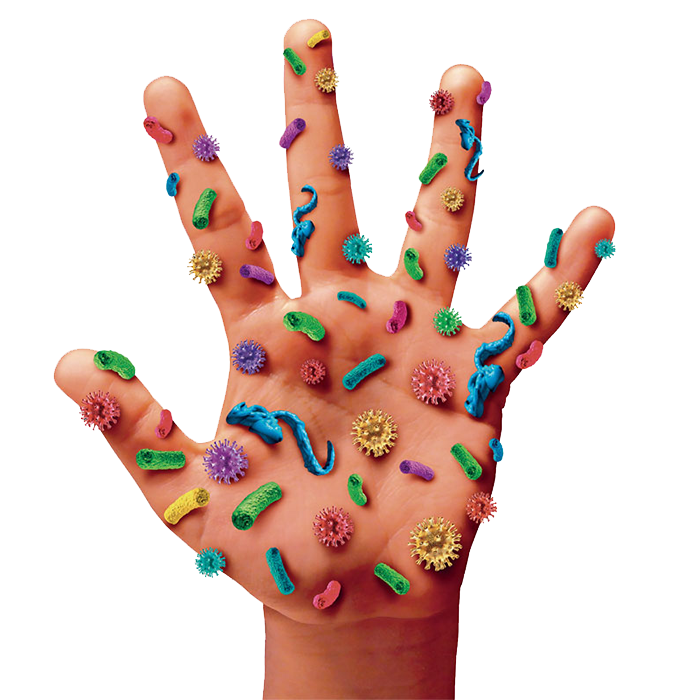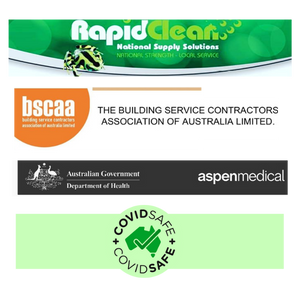Hygiene and infection control practices are important factors that contribute to a safe and healthy environment in home, hospitality, retail and other commercial buildings.
We will list on this page some actions that ALLPURPOSE CLEANERS has done and some tips on infection control



The probability that a surface, piece of equipment or room (functional area) will be contaminated is based on the activity in the area, the type of pathogens (harmful germs) involved and the microbial load (amount of germs on the surface). Areas that are heavily soiled will require more frequent cleaning and possibly disinfection than areas that are minimally soiled or not soiled (e.g. lounges, offices).
In a commercial cleaning operation areas of high soiling load could include bathrooms, kitchens, high traffic/high touch areas/fixtures such as lifts, handrails etc.
Heavy Contamination
An area is considered to be heavily contaminated if surfaces and/or equipment are exposed to copious amounts of blood or other body fluids (e.g. birthing suite, autopsy suite, cardiac catheterization laboratory, burns unit, haemodialysis unit.
This type of contamination would not be encountered on a regular basis in a commercial cleaning operation.
In the event of an infection outbreak; room cleaning procedures in commercial building or public transport may be treated in the same manner as a Heavily contaminated room (functional area).
Moderate Contamination
An area is considered to be moderately contaminated if surfaces and/or equipment are contaminated with blood or other body fluids as part of routine activity (e.g. patient/resident room, bathroom if patient/resident is incontinent) and contaminated substances are contained or removed (e.g. wet sheets). All patient/resident rooms and bathrooms should be considered to be, at a minimum, moderately contaminated.
This type of contamination would not be encountered on a regular basis in a commercial cleaning operation.
Light Contamination
An area is considered to be lightly contaminated or not contaminated if surfaces are not exposed to blood, other body fluids or items that have come into contact with blood or body fluids (e.g. lounges, libraries, offices).
Equipment
In a commercial cleaning operation it is likely cleaning equipment and cleaners trolley may become contaminated. All such cleaning equipment should be thoroughly cleaned at the end of each shift or on a more regular basis if directed by site cleaning procedures. Cleaning cloths and mops should be laundered and disinfected or disposable items such as disposable cleaning cloths used.
Important point: Dirty cleaning equipment can be a major source of infection transmission (spread) if it is not cleaned and maintained to a high standard.
In this section we will discuss the importance of regularly cleaning High Touch Surfaces.
Previous sections have introduced you to cleaning methods and process for removing soils from surfaces and the process for cleaning detergents and disinfectants to remove potentially harmful germs for surfaces.
It is important your cleaning procedures focus on cleaning high touch surfaces applying techniques to remove contaminants from the high touch surfaces, and preventing cross-contamination (spreading harmful germs).
If the facility you clean implements additional cleaning procedures because of the risk of spreading an infectious diseases such as carona virus (COVID-19), the focus of your additional cleaning procedures should be more regular cleaning of high touch surfaces.
The table below list the high touch surfaces commonly found in most commercial buildings.
General Cleaning
Patient Areas in health & aged care
1. Sink
2. Toilet seat
3. Toilet handle
4. Toilet doorknobs
5. Toilet hand hold
6. Bathroom light switch
1. Computer keyboards
2. Desks
3. Dining tables
4. Door handles
6. Hand railings
5. Light switches
6. Reception counters
7. Telephone receivers.
1. Tray table
2. Bedside table
3. Side rail
4. Call box
5. Telephone
6. Chair
7. Room doorknobs
As already discussed in Section (1) our role in cleaning is to reduce the number of germs, and by doing so, keep the building occupants healthy.
However, if we do not clean properly, we will fail to remove germs and we may actually spread an infection and make people sick.
How could our cleaning procedures spread germs and make people sick?
Using dirty cleaning equipment and in particular dirty cleaning cloths and dirty mops and buckets can spread harmful germs from one room or bathroom to another room. We can reduce the chances of our cleaning from spreading infection if we:
Change our cleaning cloths regularly and launder/wash them at the end of each shift.
Rinse or change our mops and change our bucket water regularly.
Health care and aged care require mops to be laundered/ washed each day after use.
Some clients such as food handlers, hospitals and aged care have procedures to prevent spread of harmful germs. Refer to the short course “Infection control for cleaning” for more information on infection control practices.
Failing to clean an area properly, or not cleaning an area according to specification, could increase the chances of harmful germs multiplying and spreading.
Incorrect or inappropriate cleaning techniques may spread micro-organisms around rather than removing them from the surface. The following points should form the basis of all standard operating procedures regarding cleaning in healthcare facilities:
The flow of cleaning should be from areas fixtures and fittings which are considered relatively clean to dirty. This means that areas/elements which are low touch or lightly soiled should be cleaned before areas/elements which are considered high touch or heavily soiled. For example:
When cleaning a bathroom, the toilet should be cleaned last as it is likely to be the most contaminated element in that area.
In a patient room, items that would be considered high touch would include the patient bed, call-bell, locker, over-way table, light switches, control knobs, hand basin etc., and low touch areas would include the walls, windows and floors.
In commercial buildings high touch surfaces such as door handles, light switches, hand rails etc would be the most contaminated.
The flow of cleaning should generally be from high to low reach surfaces. For example:
When dusting horizontal surfaces in a room, high areas such as those above shoulder height should be done first followed by all other elements. Dusting technique should not disperse the dust, (i.e. use damp cloths).
When using cloths and bucket/solution system to clean:
Avoid ‘double-dipping’ used cloths into the bucket containing clean, unused cloths. Doing this can contaminate the remaining clean cloths which are in the solution and result in spreading harmful germs to surfaces that are wiped thereafter.
To maximise the use of cleaning cloths, they should be folded and rotated in a manner, so as all surface areas of the cloth, including the front and back, are used progressively as elements are cleaned.
More cloths may be required to clean ‘high-touch surfaces’ compared to the same surface area of ‘low-contactsurfaces’.
With the above points taken into consideration, cleaning of an area should then be performed in a methodical way by either using a clockwise or counter-clockwise approach or a checklist for guidance.
Upon completion, the whole area should be visually checked to ensure the area is thoroughly cleaned and that surfaces have not been missed.
All elements which are broken or deteriorated to a point where cleaning is compromised should be reported and scheduled for replacement/maintenance as necessary.
Infectious micro-organisms (germs) are transmitted (spread) by five main routes. These are:
The most important and frequent means of infection transmission can be divided into two subgroups: direct contact transmission and indirect contact transmission.
Direct contact transmission occurs when infectious germs are transferred from one person to another by touching and involves transfer of micro-organisms from an infected or colonised person directly to a susceptible host.
Indirect contact transmission involves transfer of infection via contact with a contaminated object, such a high contact surface. Infectious germs can also be carried on the hands of cleaning workers through contact with other people and their surroundings. This is sometimes referred to as community based transmission.
Examples of infectious agents that are transmitted by the contact route include:
This form of transmission occurs when droplets containing infectious micro-organisms come in contact with the eyes, nose or mouth of a susceptible person.
Droplets are generated during coughing, sneezing and talking. Droplet transmission requires persons to be in close proximity, usually within a distance of one metre or less.
Examples of infectious agents that are transmitted via droplets include influenza virus corona virus (COVID-19) and whooping cough.
Airborne transmission
Airborne transmission occurs by the spreading in the air of tiny droplet nuclei or dust particles containing the infectious agent, over a distance greater than one metre. Aerosols containing infectious agents can be dispersed over long distances by air currents and inhaled by susceptible individuals who have not had any direct contact with the infectious person.
Examples of infectious agents that are transmitted via the airborne route include measles, chickenpox and tuberculosis.
Common vehicle transmission
This form of transmission occurs when the same infectious agent is transmitted to a number of people by a common contaminated source, e.g. food, water, drugs, or blood.
Vector borne transmission
This form of transmission occurs when an animal, usually an insect, transmits micro-organisms to a human host (e.g. mosquitoes, fleas and ticks).
Nn8 1pz - post code
19 dryden road
Wellingborough - Northamptonshire
contact@allpurposecleaners.com.au

Need help? Call our
All rights reserved to AllPurpose Cleaners– 2022